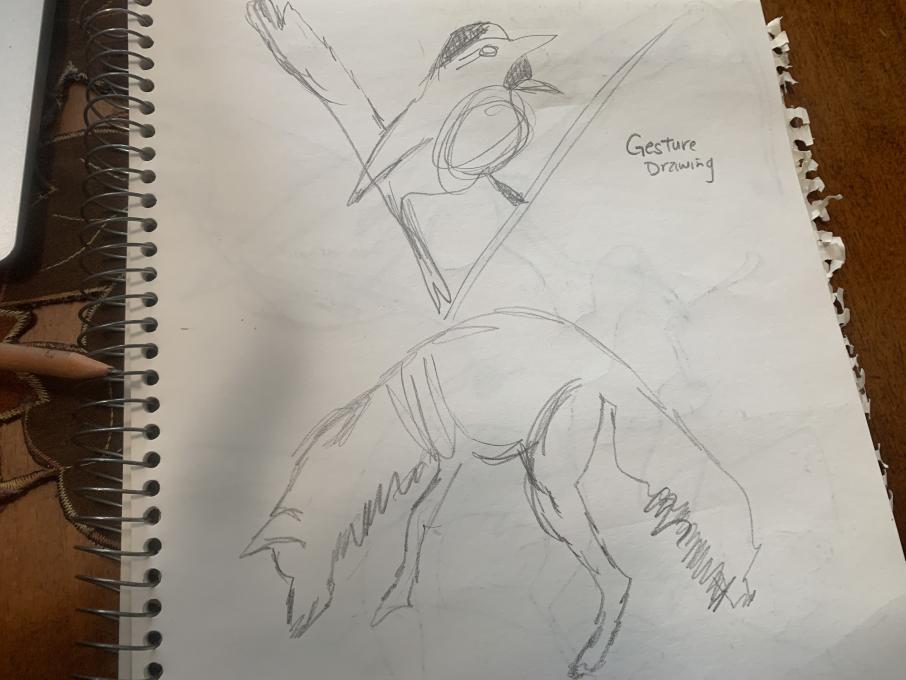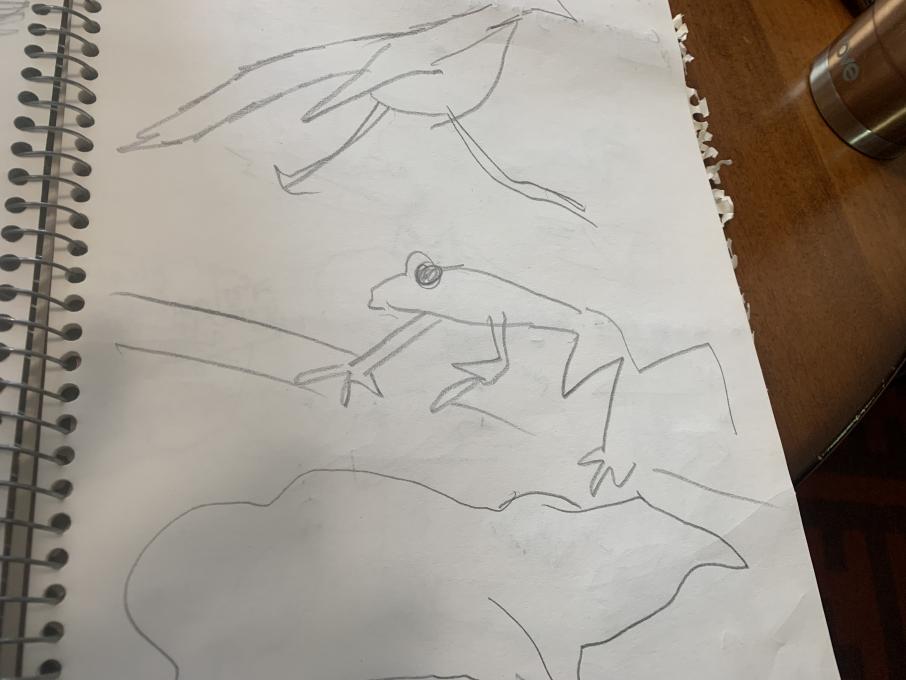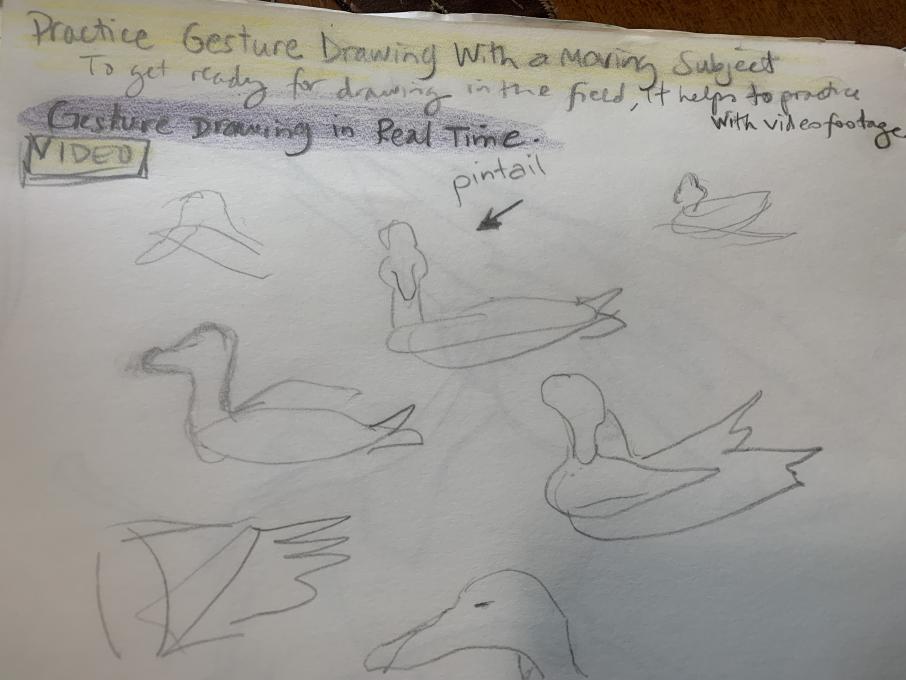The Cornell Lab Bird Academy › Discussion Groups › Nature Journaling and Field Sketching › Capturing Behavior – Gesture Drawing
-

 I don't know if it's gesture drawing or the course in general, but through these exercises, I am definitely practicing everything we have learned so far: comparing tails, shapes, colors, identifying the light, remembering specific traits, organizing the page to my liking to leave space for annotations. It's not easy but I watched the fox video 4 times to do my drawings. I can't wait to try it in the field.
I don't know if it's gesture drawing or the course in general, but through these exercises, I am definitely practicing everything we have learned so far: comparing tails, shapes, colors, identifying the light, remembering specific traits, organizing the page to my liking to leave space for annotations. It's not easy but I watched the fox video 4 times to do my drawings. I can't wait to try it in the field. -
Gesture drawing is super helpful. It requires courage! The biggest thing I've noticed is that I am having to work out what shape identifies the subject much more quickly than when drawing something still e.g. the overall shape of the subject down quickly and seeing where the detail is helpful to work out what it is and what it's doing. I am looking forward to seeing improvement in these skills - I can see how practice will be required.



-
 The usual suspects were nowhere to be found in my yard today. The local pond had more options for gesture drawing. The vultures were gathered on the far side. The geese apparently wanted a close-up so I obliged as they stood motionless—not comprehending my gesture assignment! I did get an entire page of small hieroglyphs—the distant vultures. I’ll go back early morning and get a closer view/better sit spot and try again.
The usual suspects were nowhere to be found in my yard today. The local pond had more options for gesture drawing. The vultures were gathered on the far side. The geese apparently wanted a close-up so I obliged as they stood motionless—not comprehending my gesture assignment! I did get an entire page of small hieroglyphs—the distant vultures. I’ll go back early morning and get a closer view/better sit spot and try again. -
My foxes turned out really badly at first, so I had to redo it, the second a small bit better. The birds were much easier, because I draw birds a lot.

-
Behavior of the animals
-
As a beginner in drawing in general, all of the exercises are challenging to me. Gesture drawing requires lots of focus and concentration. I also realise the benefits of practicing blind contour drawing in preparation for gesture drawing as you need to sometimes draw while looking at the subject.
-
 There's often a huge flock of geese (>75 birds) grazing on grass shoots on the banks of the Neckar in Heidelberg. I've been wanting to check them out up close for some time and this exercise was a great incentive. I learned so much sitting among them watching. They move like dinosaurs! There are at least four breeds sharing the space (greylag, swan, Canadian, and Egyptian) - though they keep to their own within that space. There are individual birds among the swan geese that steer the entire flock with honking calls; the breeds have quite different sounding honks. The air was filled with the sound of their grazing!
There's often a huge flock of geese (>75 birds) grazing on grass shoots on the banks of the Neckar in Heidelberg. I've been wanting to check them out up close for some time and this exercise was a great incentive. I learned so much sitting among them watching. They move like dinosaurs! There are at least four breeds sharing the space (greylag, swan, Canadian, and Egyptian) - though they keep to their own within that space. There are individual birds among the swan geese that steer the entire flock with honking calls; the breeds have quite different sounding honks. The air was filled with the sound of their grazing! -
Gesture drawing helped me to realize how much motion is in wildlife. It is really hard to capture it in a sketch. I think the blind contour drawing has helped me to capture these skittish creatures. The Blue Jays, squirrels, cardinals were a real challenge. I noticed their behavior is more detail that I had never noticed before. Great lesson!
-


-
The duck was easier, it was closer, it didn't move as much and I am used to draw birds, but the foxes were more difficult for me, so I tried first stoping the video just to have an idea of which were their main features, then, I played the video several times and and tried to concentrate in only one of them to gasp its gestures.


-
Regarding gesture drawing a live or moving animal: if I keep at it, I will catch a moment or an angle of head or wing or tail that is distinctly that animal’s movement. That is satisfying...looking back and seeing what the animal is up to.
-
 Gesture drawing was very helpful in the field. It took some time to begin to see the angles of the wings, to figure out the movements, what they did to take off and to land, but the more I practiced the easier I could see. I was pleased with the fore-shortening when the Gull flew toward me. My best experience was when I parked and just sat there and focused on the birds for an hour. I needed lots of the birds so I could start and stop until I saw a repeated patterns. I picked gulls because I have a problem identifying species.
I noticed that flying posture can be totally different between species. I also could identify classes of species very quickly from a distance. I felt it was almost easier to be at a distance to capture gesture because if I could see detail I would slow down and try to record the detail over the gesture.
Gesture drawing was very helpful in the field. It took some time to begin to see the angles of the wings, to figure out the movements, what they did to take off and to land, but the more I practiced the easier I could see. I was pleased with the fore-shortening when the Gull flew toward me. My best experience was when I parked and just sat there and focused on the birds for an hour. I needed lots of the birds so I could start and stop until I saw a repeated patterns. I picked gulls because I have a problem identifying species.
I noticed that flying posture can be totally different between species. I also could identify classes of species very quickly from a distance. I felt it was almost easier to be at a distance to capture gesture because if I could see detail I would slow down and try to record the detail over the gesture. -
Of course gesture drawing causes me to pay more attention! I think that I chose an unfortunate subject to try in the field: dragonflies. I thought birds could move quickly, but they are slow-pokes compared to dragonflies. Dragonflies were fun to watch, but they also made me dizzy since they moved so fast. The birds at my feeder were a little better to observe.

-
Catching an entire bird before it moves on is a challenge, but it is fun to try.

-
Challenging; fun to try to capture their movements. I think it will help put more life and character of each animal in our drawings. Thanks for posting these fun videos
-

 Gesture drawing did help me observing the birds -- Yet, they were too fast to be sketched. I kept my camera and phone away (cause I have this tendency of photographing and videoing the birds to be able to sketch them later) I forced myself to just sketch with my pen or pencil. I thought of sketching the shapes only - then I went deeper to observe each part of their anatomy. Their heads, their legs, their "closed" wings and "opened wings. I also was able to focus on their gestures while drinking water, specifically speaking, how their bodies' bend and how it rise while drinking. I've didn't give it much of thought before.
Luckily, I noticed a Dove in her nest above my head. There were lots of branches between us , but I tried to get her eye while looking at me :)
I have noticed the uniqueness of the house sparrows's black marks on its wings -- both males and females. I've never noticed / or better said / never thought of it until I was sketching their closed wings while standing.
Real-life sketching was a bit hard because they were flying away at the minimal movements. Also, they were far away and small in size, I believe this made me sketch tinny sketches :/
It just occurred to my mind that I tend to pick tinny small creatures to sketch.. I'll look for a much larger bird next!
Gesture drawing did help me observing the birds -- Yet, they were too fast to be sketched. I kept my camera and phone away (cause I have this tendency of photographing and videoing the birds to be able to sketch them later) I forced myself to just sketch with my pen or pencil. I thought of sketching the shapes only - then I went deeper to observe each part of their anatomy. Their heads, their legs, their "closed" wings and "opened wings. I also was able to focus on their gestures while drinking water, specifically speaking, how their bodies' bend and how it rise while drinking. I've didn't give it much of thought before.
Luckily, I noticed a Dove in her nest above my head. There were lots of branches between us , but I tried to get her eye while looking at me :)
I have noticed the uniqueness of the house sparrows's black marks on its wings -- both males and females. I've never noticed / or better said / never thought of it until I was sketching their closed wings while standing.
Real-life sketching was a bit hard because they were flying away at the minimal movements. Also, they were far away and small in size, I believe this made me sketch tinny sketches :/
It just occurred to my mind that I tend to pick tinny small creatures to sketch.. I'll look for a much larger bird next! -
Hi, I tried to write on my last photo with picture and made a mistake; submitted without writing something. I sent a gesture drawing I did of a webcam online as there wasn't much activity when I was outside at my feeders. this i found that I was more focused than the pin-tail Duck moving around on the screen. I am feeling more relaxed and will continue to practice outside. The drawing I did was at the Cornell's Webcam that was recorded last week with a lot of activity even a Baltimore Oriole eating an orange. This is fun!!!
-

-
I've done gesture drawing with a live model in a pose, but trying to capture a moving animal is really challenging!!

-

-
 This was definitely a hard exercise/lesson to do for me. I was very stressed with the one minute & 30 second time limits that I just had to step away from drawing for a couple of days. I am not comfortable with the being messy/loose technique. The two minutes limit & just sitting & doing the gesture drawings at the feeders were more comfortable and relaxed for me. I do feel & think that gesture/behavior drawing has helped me focus on more specific things during my observations. I have noticed specific movements & patterns/rhythms the animals do. While this wasn’t my most comfortable task, learning to be gentle with the results & learning how to master this skill is definitely important. I will be incorporating a daily gesture drawing in my journaling observations & experiences. Like all skills to master, it takes practice, practice, practice.
This was definitely a hard exercise/lesson to do for me. I was very stressed with the one minute & 30 second time limits that I just had to step away from drawing for a couple of days. I am not comfortable with the being messy/loose technique. The two minutes limit & just sitting & doing the gesture drawings at the feeders were more comfortable and relaxed for me. I do feel & think that gesture/behavior drawing has helped me focus on more specific things during my observations. I have noticed specific movements & patterns/rhythms the animals do. While this wasn’t my most comfortable task, learning to be gentle with the results & learning how to master this skill is definitely important. I will be incorporating a daily gesture drawing in my journaling observations & experiences. Like all skills to master, it takes practice, practice, practice. -


-

-

-

Read More:
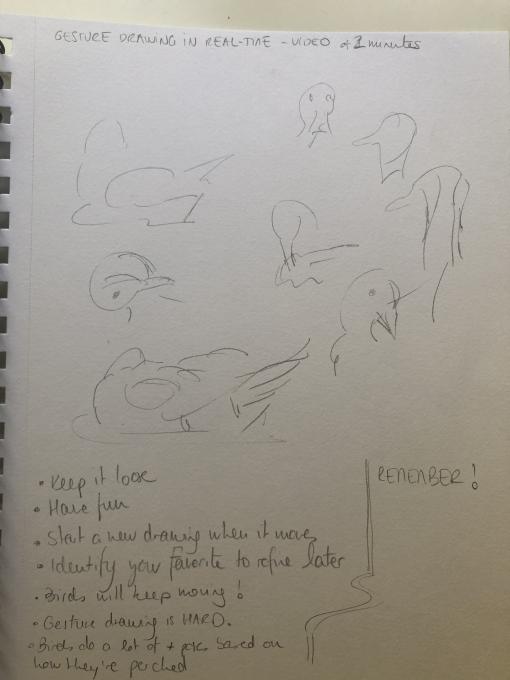
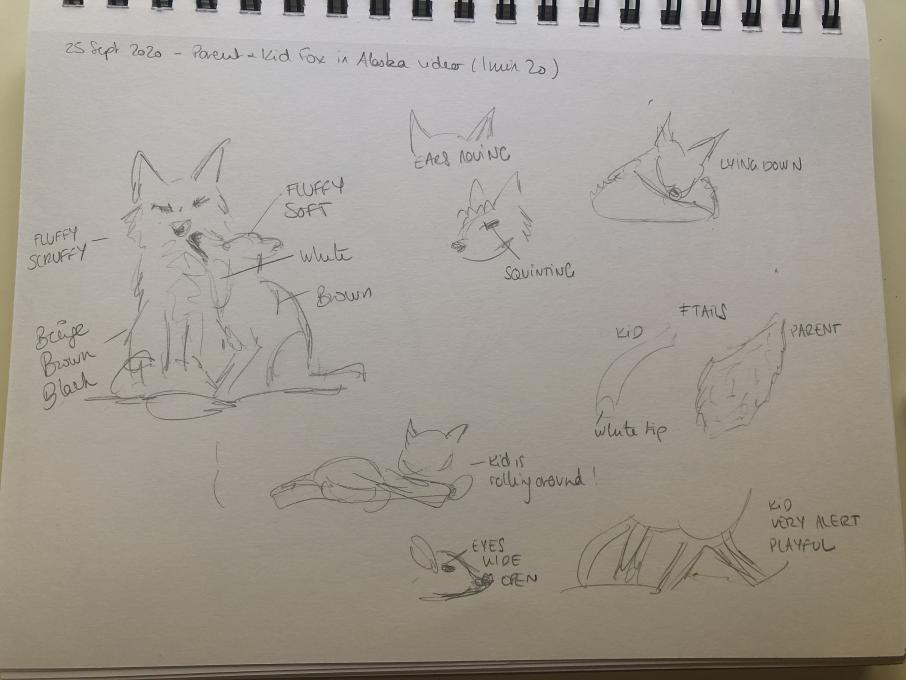 I don't know if it's gesture drawing or the course in general, but through these exercises, I am definitely practicing everything we have learned so far: comparing tails, shapes, colors, identifying the light, remembering specific traits, organizing the page to my liking to leave space for annotations. It's not easy but I watched the fox video 4 times to do my drawings. I can't wait to try it in the field.
I don't know if it's gesture drawing or the course in general, but through these exercises, I am definitely practicing everything we have learned so far: comparing tails, shapes, colors, identifying the light, remembering specific traits, organizing the page to my liking to leave space for annotations. It's not easy but I watched the fox video 4 times to do my drawings. I can't wait to try it in the field. 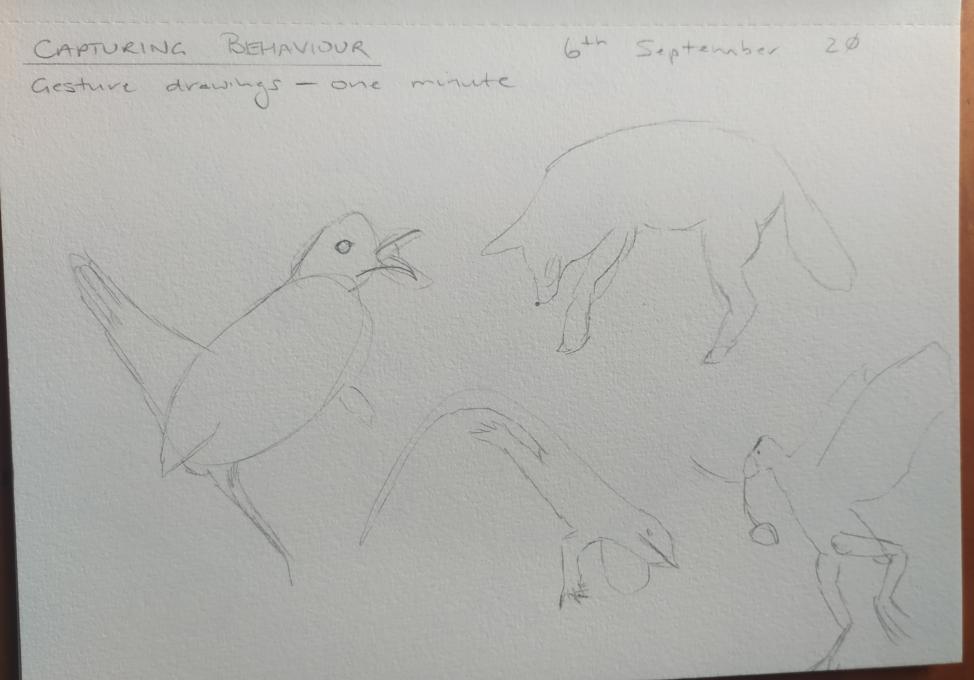
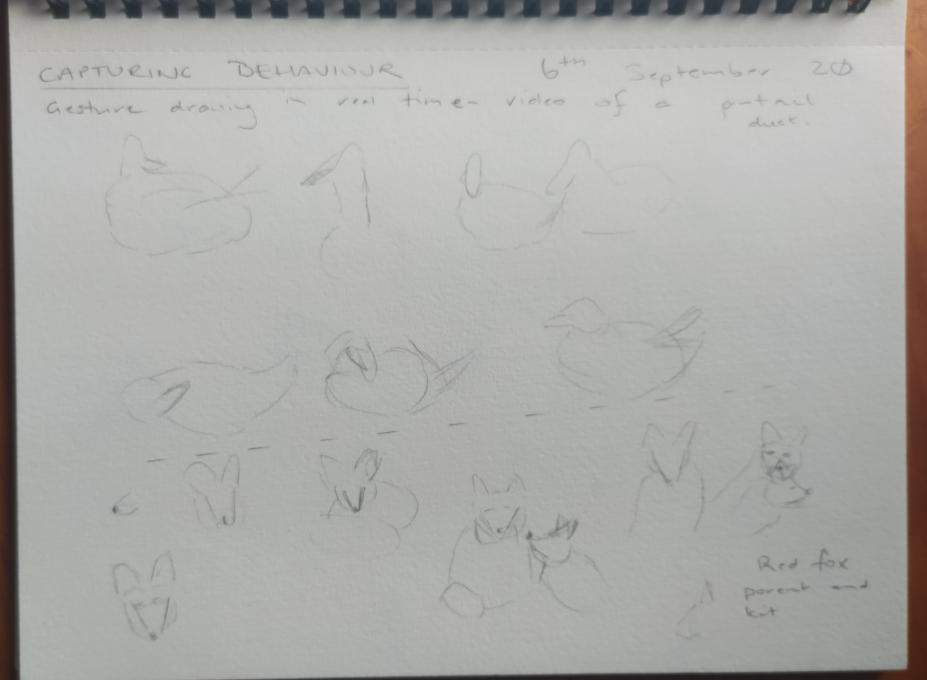

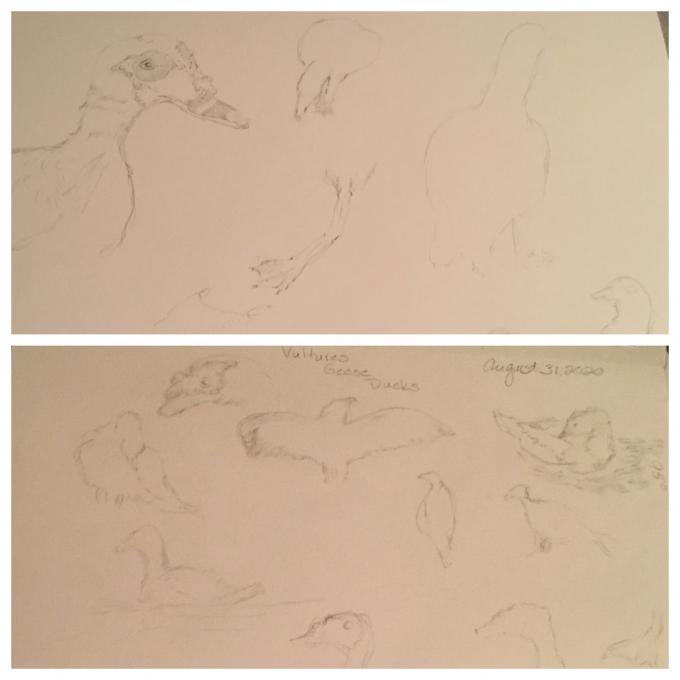 The usual suspects were nowhere to be found in my yard today. The local pond had more options for gesture drawing. The vultures were gathered on the far side. The geese apparently wanted a close-up so I obliged as they stood motionless—not comprehending my gesture assignment! I did get an entire page of small hieroglyphs—the distant vultures. I’ll go back early morning and get a closer view/better sit spot and try again.
The usual suspects were nowhere to be found in my yard today. The local pond had more options for gesture drawing. The vultures were gathered on the far side. The geese apparently wanted a close-up so I obliged as they stood motionless—not comprehending my gesture assignment! I did get an entire page of small hieroglyphs—the distant vultures. I’ll go back early morning and get a closer view/better sit spot and try again. 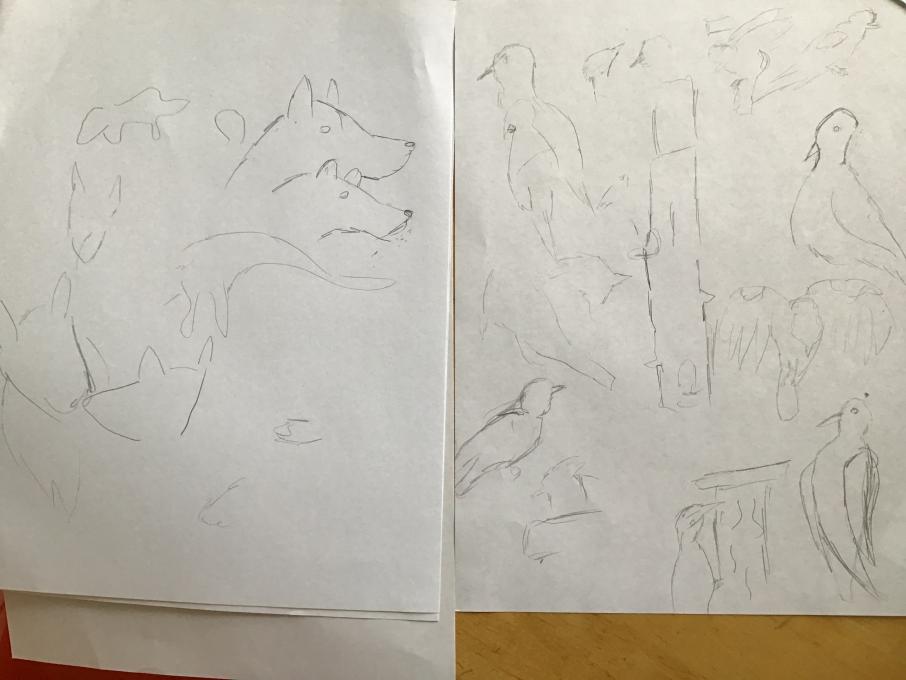
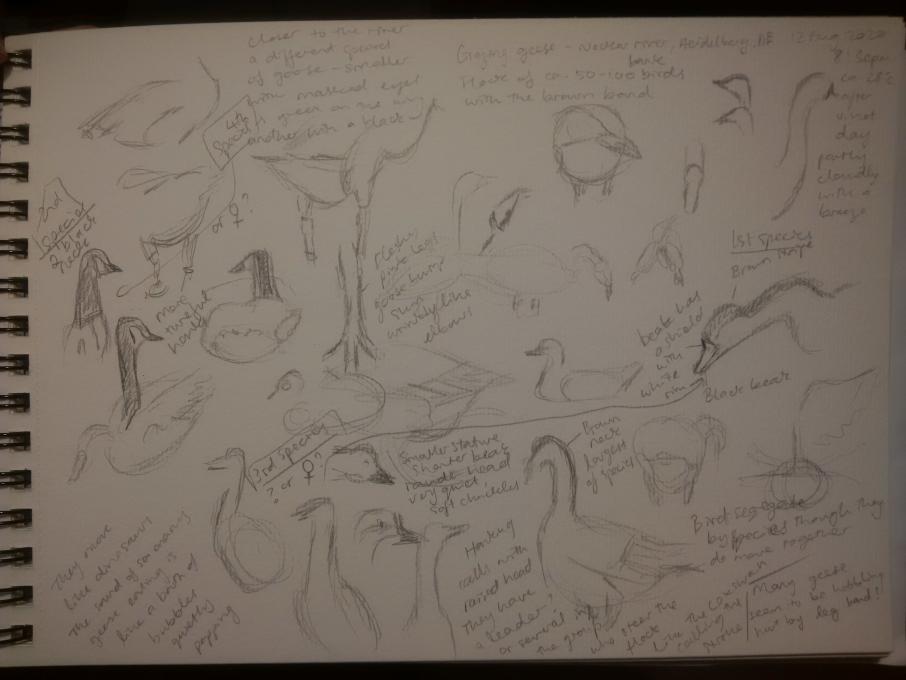 There's often a huge flock of geese (>75 birds) grazing on grass shoots on the banks of the Neckar in Heidelberg. I've been wanting to check them out up close for some time and this exercise was a great incentive. I learned so much sitting among them watching. They move like dinosaurs! There are at least four breeds sharing the space (greylag, swan, Canadian, and Egyptian) - though they keep to their own within that space. There are individual birds among the swan geese that steer the entire flock with honking calls; the breeds have quite different sounding honks. The air was filled with the sound of their grazing!
There's often a huge flock of geese (>75 birds) grazing on grass shoots on the banks of the Neckar in Heidelberg. I've been wanting to check them out up close for some time and this exercise was a great incentive. I learned so much sitting among them watching. They move like dinosaurs! There are at least four breeds sharing the space (greylag, swan, Canadian, and Egyptian) - though they keep to their own within that space. There are individual birds among the swan geese that steer the entire flock with honking calls; the breeds have quite different sounding honks. The air was filled with the sound of their grazing! 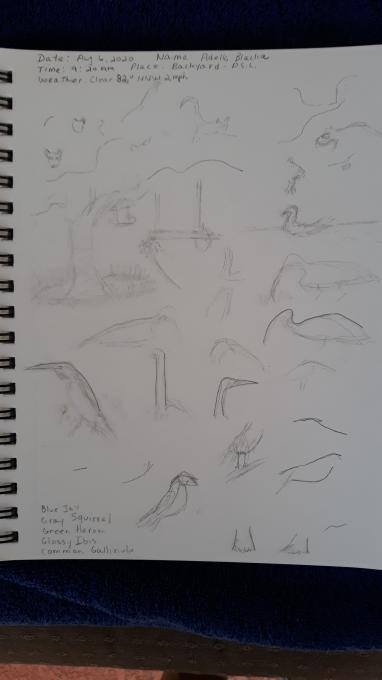
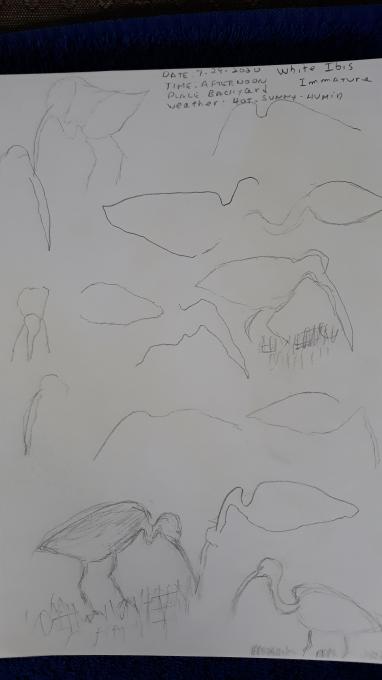
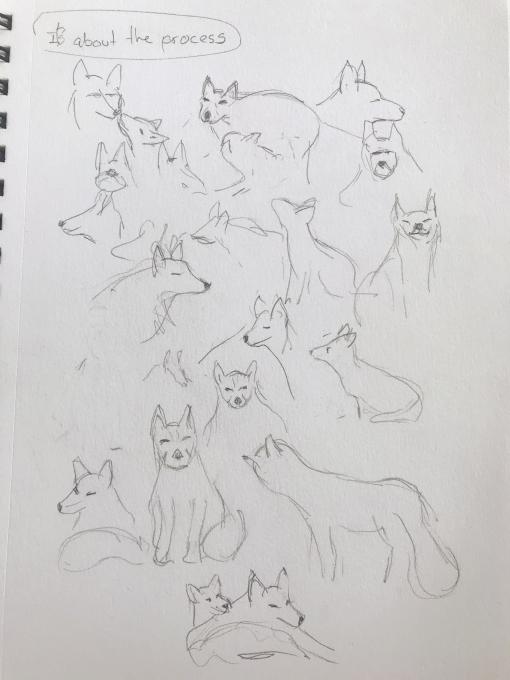

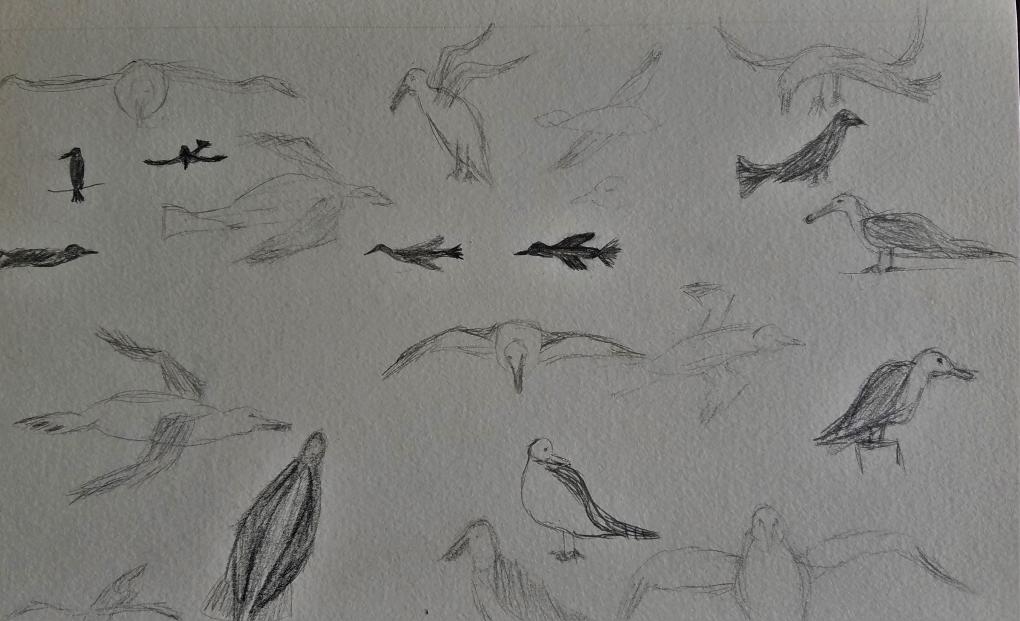 Gesture drawing was very helpful in the field. It took some time to begin to see the angles of the wings, to figure out the movements, what they did to take off and to land, but the more I practiced the easier I could see. I was pleased with the fore-shortening when the Gull flew toward me. My best experience was when I parked and just sat there and focused on the birds for an hour. I needed lots of the birds so I could start and stop until I saw a repeated patterns. I picked gulls because I have a problem identifying species.
I noticed that flying posture can be totally different between species. I also could identify classes of species very quickly from a distance. I felt it was almost easier to be at a distance to capture gesture because if I could see detail I would slow down and try to record the detail over the gesture.
Gesture drawing was very helpful in the field. It took some time to begin to see the angles of the wings, to figure out the movements, what they did to take off and to land, but the more I practiced the easier I could see. I was pleased with the fore-shortening when the Gull flew toward me. My best experience was when I parked and just sat there and focused on the birds for an hour. I needed lots of the birds so I could start and stop until I saw a repeated patterns. I picked gulls because I have a problem identifying species.
I noticed that flying posture can be totally different between species. I also could identify classes of species very quickly from a distance. I felt it was almost easier to be at a distance to capture gesture because if I could see detail I would slow down and try to record the detail over the gesture. 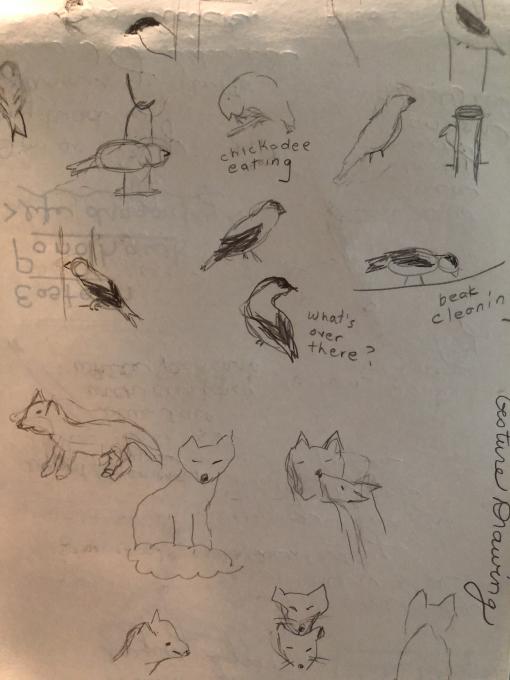
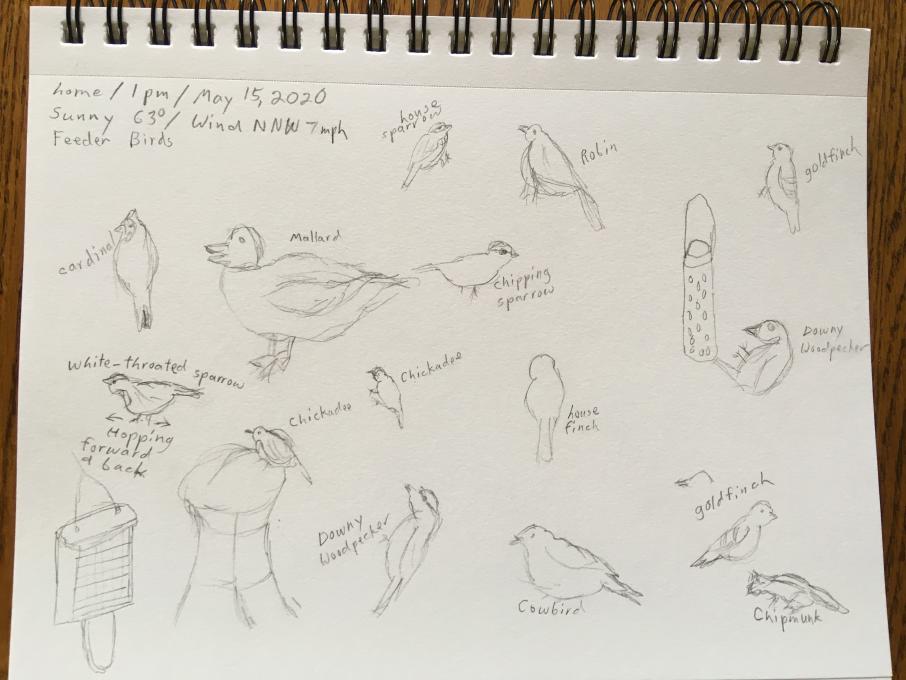

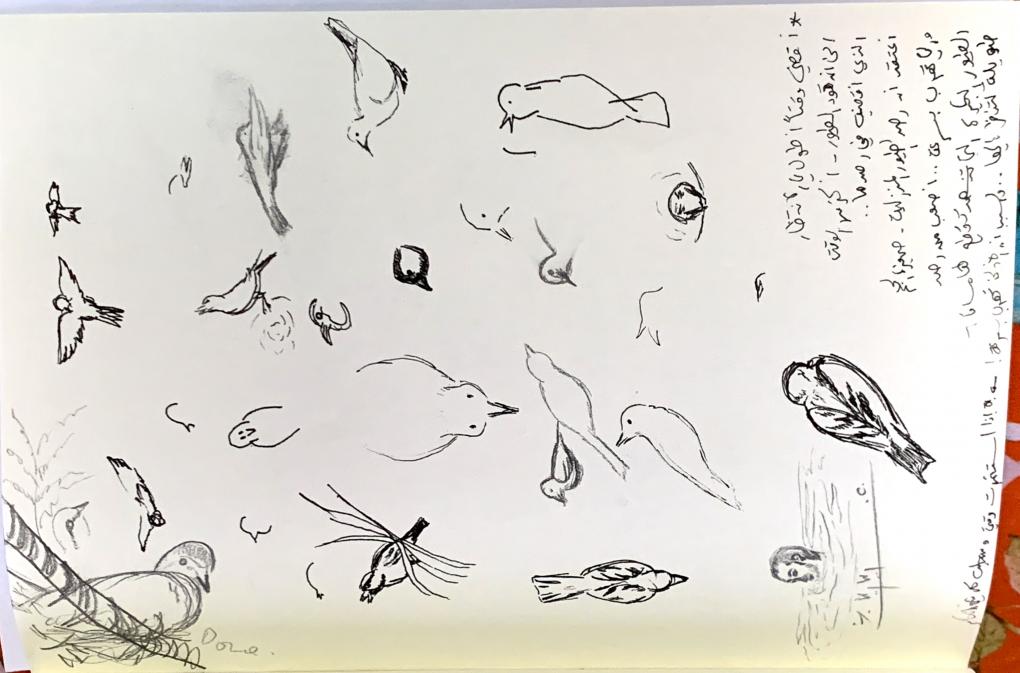 Gesture drawing did help me observing the birds -- Yet, they were too fast to be sketched. I kept my camera and phone away (cause I have this tendency of photographing and videoing the birds to be able to sketch them later) I forced myself to just sketch with my pen or pencil. I thought of sketching the shapes only - then I went deeper to observe each part of their anatomy. Their heads, their legs, their "closed" wings and "opened wings. I also was able to focus on their gestures while drinking water, specifically speaking, how their bodies' bend and how it rise while drinking. I've didn't give it much of thought before.
Luckily, I noticed a Dove in her nest above my head. There were lots of branches between us , but I tried to get her eye while looking at me :)
I have noticed the uniqueness of the house sparrows's black marks on its wings -- both males and females. I've never noticed / or better said / never thought of it until I was sketching their closed wings while standing.
Real-life sketching was a bit hard because they were flying away at the minimal movements. Also, they were far away and small in size, I believe this made me sketch tinny sketches :/
It just occurred to my mind that I tend to pick tinny small creatures to sketch.. I'll look for a much larger bird next!
Gesture drawing did help me observing the birds -- Yet, they were too fast to be sketched. I kept my camera and phone away (cause I have this tendency of photographing and videoing the birds to be able to sketch them later) I forced myself to just sketch with my pen or pencil. I thought of sketching the shapes only - then I went deeper to observe each part of their anatomy. Their heads, their legs, their "closed" wings and "opened wings. I also was able to focus on their gestures while drinking water, specifically speaking, how their bodies' bend and how it rise while drinking. I've didn't give it much of thought before.
Luckily, I noticed a Dove in her nest above my head. There were lots of branches between us , but I tried to get her eye while looking at me :)
I have noticed the uniqueness of the house sparrows's black marks on its wings -- both males and females. I've never noticed / or better said / never thought of it until I was sketching their closed wings while standing.
Real-life sketching was a bit hard because they were flying away at the minimal movements. Also, they were far away and small in size, I believe this made me sketch tinny sketches :/
It just occurred to my mind that I tend to pick tinny small creatures to sketch.. I'll look for a much larger bird next! 
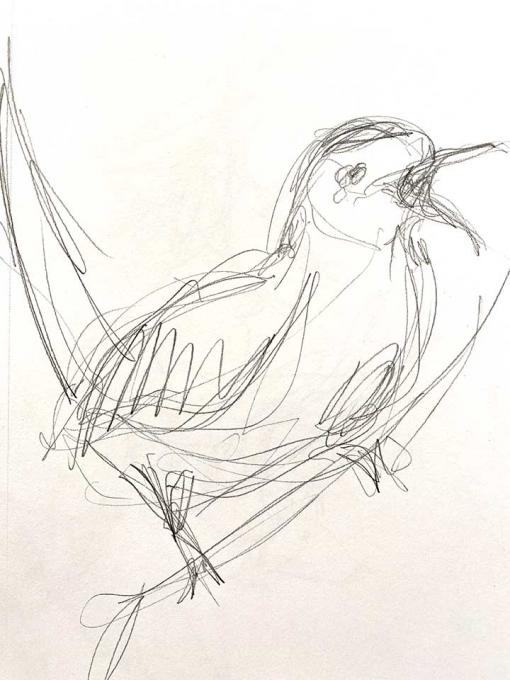
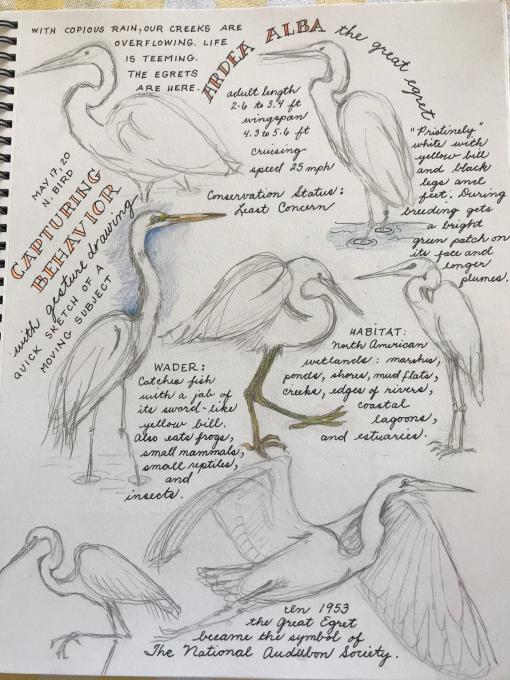
 This was definitely a hard exercise/lesson to do for me. I was very stressed with the one minute & 30 second time limits that I just had to step away from drawing for a couple of days. I am not comfortable with the being messy/loose technique. The two minutes limit & just sitting & doing the gesture drawings at the feeders were more comfortable and relaxed for me. I do feel & think that gesture/behavior drawing has helped me focus on more specific things during my observations. I have noticed specific movements & patterns/rhythms the animals do. While this wasn’t my most comfortable task, learning to be gentle with the results & learning how to master this skill is definitely important. I will be incorporating a daily gesture drawing in my journaling observations & experiences. Like all skills to master, it takes practice, practice, practice.
This was definitely a hard exercise/lesson to do for me. I was very stressed with the one minute & 30 second time limits that I just had to step away from drawing for a couple of days. I am not comfortable with the being messy/loose technique. The two minutes limit & just sitting & doing the gesture drawings at the feeders were more comfortable and relaxed for me. I do feel & think that gesture/behavior drawing has helped me focus on more specific things during my observations. I have noticed specific movements & patterns/rhythms the animals do. While this wasn’t my most comfortable task, learning to be gentle with the results & learning how to master this skill is definitely important. I will be incorporating a daily gesture drawing in my journaling observations & experiences. Like all skills to master, it takes practice, practice, practice. 